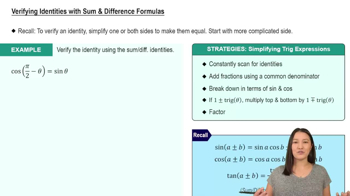Textbook Question
Use one or more of the six sum and difference identities to solve Exercises 13–54.In Exercises 13–24, find the exact value of each expression.sin 75°
772
views
 Verified step by step guidance
Verified step by step guidance Verified video answer for a similar problem:
Verified video answer for a similar problem:



 6:14m
6:14mMaster Sum and Difference of Sine & Cosine with a bite sized video explanation from Patrick
Start learning